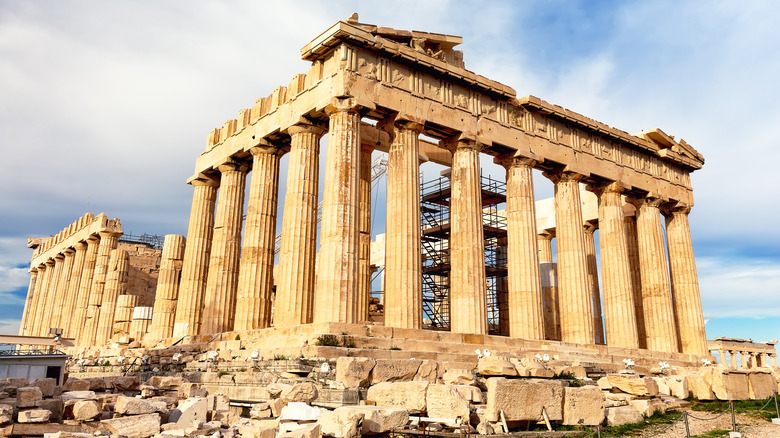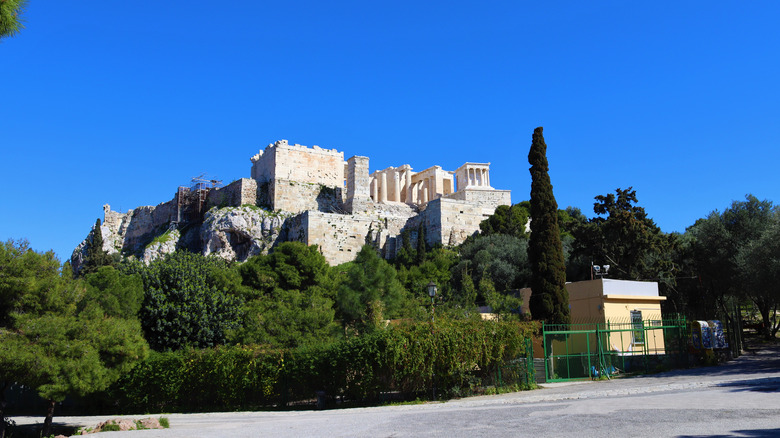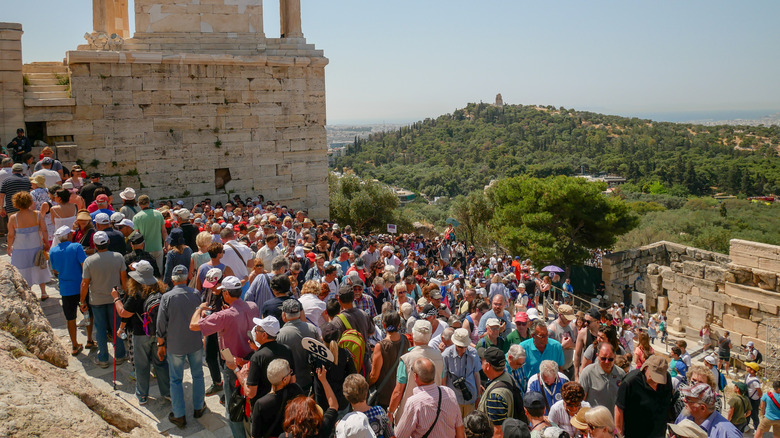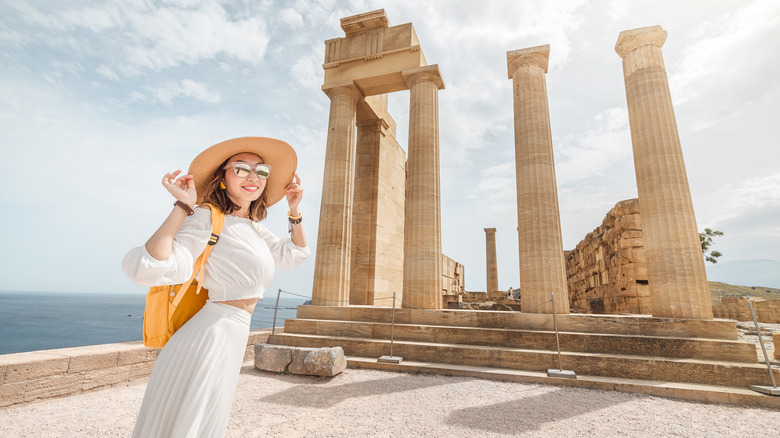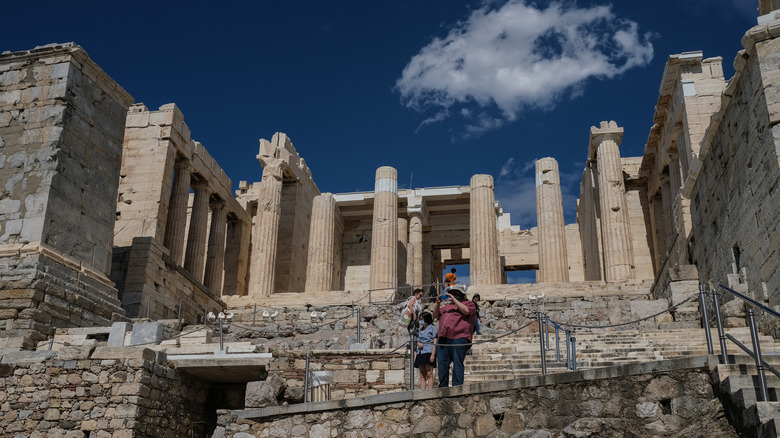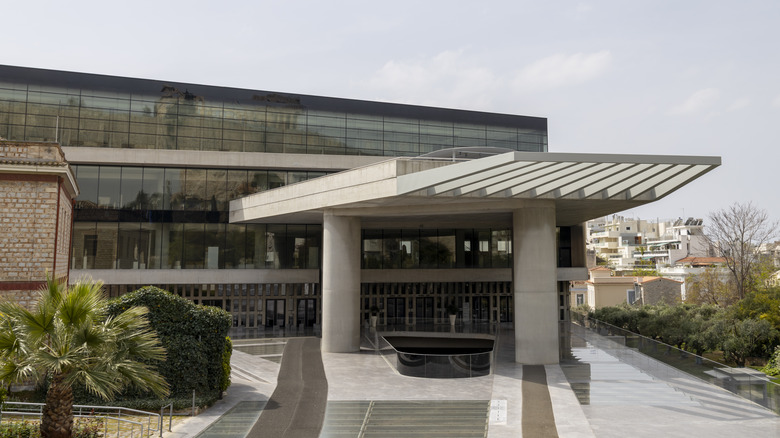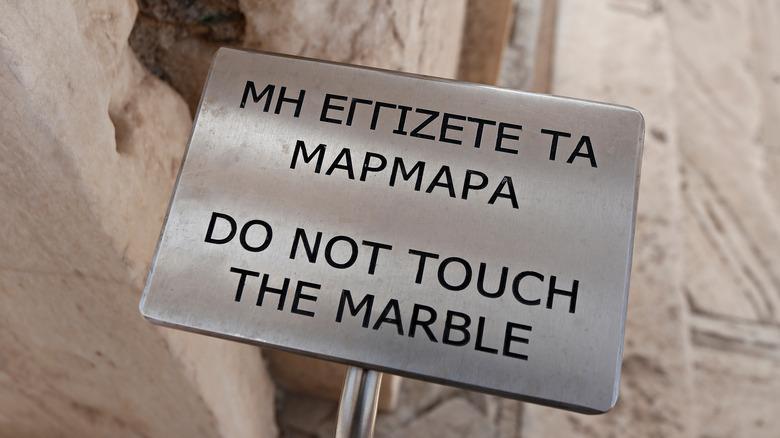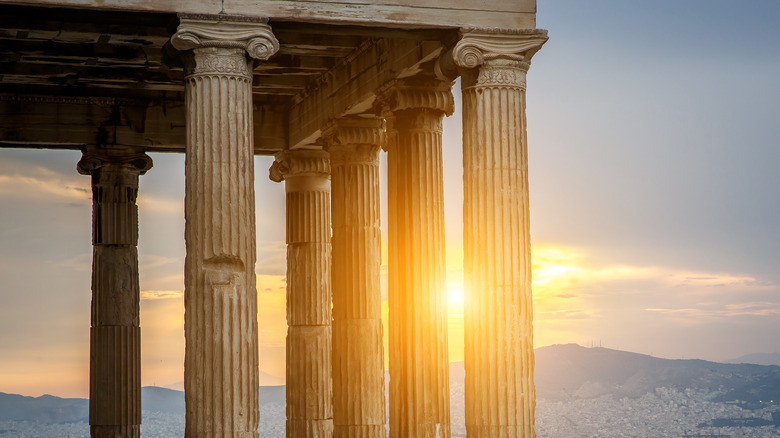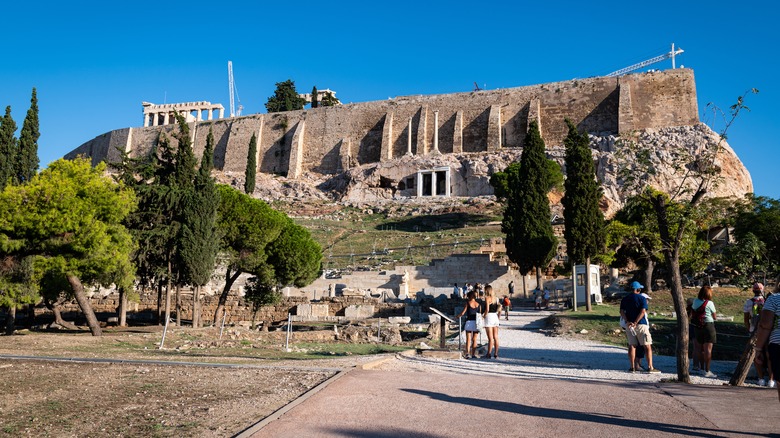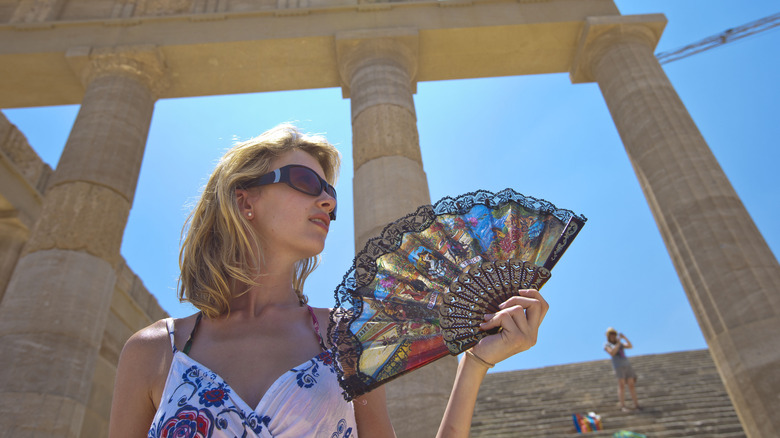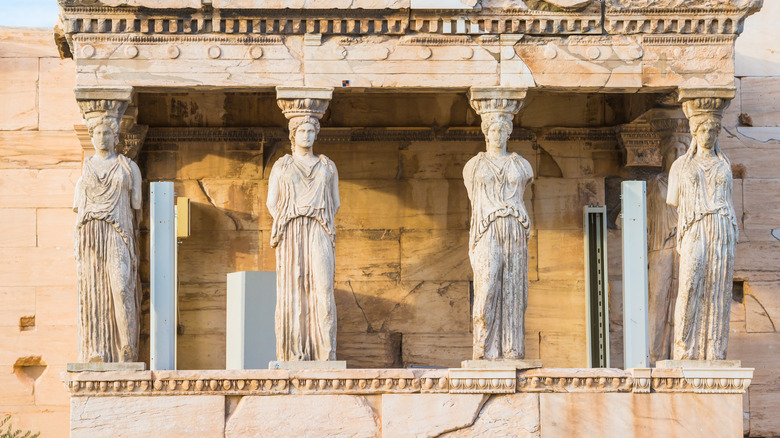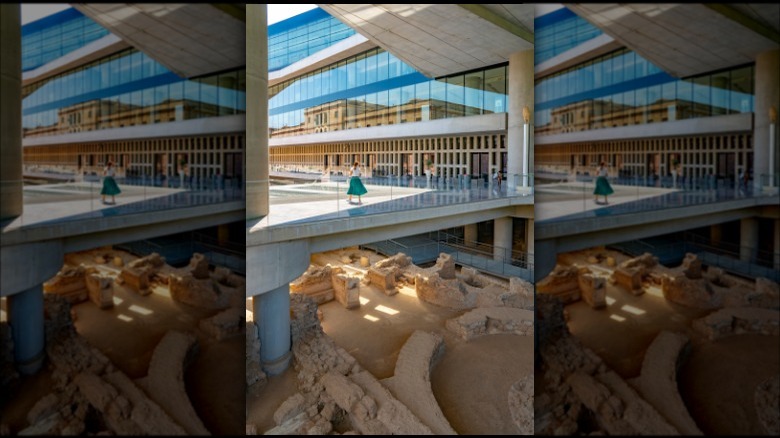Your Guide To Visiting The Acropolis In Athens, Greece
When visiting Greece, one of the must-see locations for travelers is definitely the Acropolis. What first-time visitors might not know is that the site itself is actually the Acropolis while the other buildings have their own names, like the Parthenon, Propylaia, Erechtheion, and more. The UNESCO World Heritage site is certainly a well-photographed piece of Athenian history with plenty to teach us about ancient Greeks.
According to UNESCO, the Acropolis is the grandest and most complete complex of ancient Greek architecture that survived to today. The first walls around the site were put up during the 13th century BC and the monuments dotting the property have survived countless hazards in their 2500 years, per the site. The Acropolis site itself is truly a marvel to behold and while it isn't one of the wonders of the world, it's definitely a wonder in itself.
The Greek name "Acropolis" translates into a few variations: "High City," "City on the Extremity," and "City on the Air," according to Ganymedes. All three phrases are fitting as the site looms large over Athens as if the ancients themselves are watching over present-day Grecians. Although many artifacts were taken to the British Museum (and the Greek government continues fighting to have them returned), there are many pieces of ancient art to gaze at within the Acropolis. While this is a top destination for tourists, there are still rookie mistakes that can dampen your experience. Let's go through some tips and tricks to make your visit to the Acropolis the best it can be.
Get tickets beforehand
Going to the Acropolis is at the top of a lot of travelers' lists when visiting Greece. That said, if you don't buy your entry tickets in advance, you will be stuck behind a lot of those travelers. Purchasing tickets ahead of time saves you so much time! When buying ahead of time you can also purchase a skip-the-line ticket which will save you even more time at the entry gate. It's important to note that advanced tickets are not automatically skip-the-line tickets, so pay attention to what you're purchasing (via Travel Infused Life).
Besides getting tickets ahead of time, be sure you're also not planning on visiting when it's a free day unless you feel like waiting around for a long time. Free access days are when you'll encounter the most tourists and locals alike, so pay attention to those dates (via Headout). Purchasing skip-the-line tickets won't save you money, but it will keep you from waiting around in line for a few hours just to get into the site. If you've ever had to stand in one spot in the grueling Grecian heat in the middle of summer, you will understand the appeal of skipping the line.
Timing is everything
At this site, when you go will determine so much about your experience. Going to the Acropolis very early in the day or late means it will be significantly less crowded. Not only that but you will be saved from the torture of the sun at high noon. Don't forget that you're on top of a large hill, so it gets pretty toasty at midday, especially if you visit in the hot months. Your best bet for small crowds early in the day is to go to the site before 9 a.m., according to Greek Travel Tellers. Why? Because 9 a.m. brings the cruise ship crowds and a flood of tourists.
If you're not a morning person (we get it), going to the Acropolis in the evening is also a treat. Make sure you give yourself at least two hours before the site closes for the day to really enjoy it. But the evening brings cooler weather, fewer crowds, and the potential to see a stunning sunset from the top of the hill.
Per Acropolis Tickets, 11 a.m. to 1 p.m. is the busiest time at the site, particularly during the heaviest visiting season of April to October. So whether you are an early bird or not, try to time your visit so you get the most out of the excursion.
Dress for the elements
Being on the hill that overlooks Athens comes with some incredible views — and extreme sun exposure. Seriously, there are very few (if any) shady spots once you get up the hill. Be prepared to be in full sun unless you luck out on a cloudy day. Particularly if you're visiting Greece in the summer, be more aware of the heat. You'll want lots of sunscreen, UV-protective clothing, sunglasses, and comfortable shoes.
You don't have to worry about a dress code here like some of the other sites around like the Greek Monasteries, so just be comfortable (via Travel the Greekway). Consider wearing clothes that are breathable and cooling so you don't feel so sticky in the heat, per You Could Travel. It can be windy at the top of the hill, so keep that in mind if you plan on wearing a hat or a dress/skirt on the excursion.
Wear good shoes
Trekking to the Parthenon at the top of the Acropolis isn't a particularly difficult hike. Without stopping, it takes about 20 minutes. However, many of the stone stairs have been worn down from use so they are very slippery, especially if it's been raining. Parts of the walk can be steep and uneven, though there is an elevator that can be utilized for folks with walking difficulties or wheelchairs. There are times when the elevator is out of order, so contact the site ahead of time before you go if you need to use it, via Wonderful Wanderings.
Don't feel rushed to just get to the top of the hill as soon as you can. Take your time and enjoy the monuments along the way. Places to rest or even the rare shady spots dot the path for moments of contemplation. Even the trek up the hill itself is figuratively breathtaking just in the sheer magnitude of the sites you are approaching. Walking steadily toward iconic architecture like the Parthenon is magnificent.
The path leading up to the Parthenon has so many signs, artifacts, and things to see that make the hike so much more interesting. So wear good shoes with grip to avoid slipping and just enjoy the hike. The top will still be there even if you don't go running up the hill (cue that Kate Bush song).
Check out the museum
Surprisingly, visitors can visit the Acropolis and think that's all there is to the archaeological discovery. However, the Acropolis Museum nearby is an expansive array of ruins, explanations, and depictions of how the high city once looked. You can even see archaeological dig sites as they were when scientists excavated them, which is quite a unique experience.
One of the most unique elements of the museum is the top floor Parthenon Gallery, which showcases the sculptures of the architecture as they might have been when the Parthenon was built. Discover Greece recommends dedicating two to three hours to this 14,000-square-foot behemoth of a museum.
Since it opened in 2009, the Acropolis Museum has become one of the highlights for visitors to Athens, according to Athens by Locals. What is also incredible about this museum is the basement level, which shows excavation sites of an ancient Athenian neighborhood that you can see up close from a walkway or from above through glass floors. It is likely that the Acropolis Museum will be unlike any museum you've toured before.
Obey the signage
Signs that say "do not touch" or anything equivalent at an ancient site like the Acropolis are not just making a suggestion. Absolutely do not touch, stand on or sit on the ruins. There are areas where you can rest that aren't made of ancient marble. You'll probably notice the guards standing around the site, particularly up by the Parthenon. You'll hear them, too, if someone touches something they aren't supposed to touch. A shout or a whistle will alert you right away if someone literally goes over the line. Don't leave even a water bottle on a marble slab either, that counts (per Little Owl Tours).
Be mindful of where you're walking (or climbing) at all times, especially up the hill at the Acropolis. Not only can you get in trouble for climbing where you aren't supposed to be, but it's also dangerous to do so. That's why there are so many roped-off areas.
Additionally, you are more than welcome to take photographs, but keep in mind that the Acropolis is an ancient space. Certain poses are considered inappropriate depending on who is around you that day. Don't be lewd around the statues or pose provocatively on the grounds, it's not allowed. Flags, mascots, and other such objects are also not permitted to be photographed with monuments behind them.
Don't rush
Operating hours at the Acropolis are no joke. If you arrive with just enough time to get to the top of the hill and snap a picture, you will be hounded to exit when the site closes. When the site is closed, it is closed. So, unless you want to rush out of the property at the end of your visit in a sea of hurried tourists, give yourself enough time to enjoy the Acropolis.
The time of year that you visit the Acropolis will dictate the hours of operation, though the final entry is always a half hour prior to closing, according to Greece Travel Secrets. Remember that it will take roughly 20 minutes to get to the top of the hill if you don't stop to look at monuments along the way. And absolutely don't save your photos for the very end of the visit because you will be scolded by the guards for stopping when you should be exiting.
Use the second entrance
Digital maps will automatically take you to the main entrance of the Acropolis, but that is where you'll find the longest entry lines. If you go in via the secondary entrance you will get more time at the site itself. The secondary entrance is located on the southeast side of the grounds and is known as the Dionysius Theater entrance because it's near the Theatre of Dionysus ruin, per Athens Walking Tours. You may encounter a line at this other entrance, though it is unlikely to be even a fraction as long as the main entry point.
Headout notes that the wait to enter the Acropolis from the main entrance ranges from 20-30 minutes for folks with advanced tickets but up to several hours for those who buy tickets at the gate. It should be noted that parking near the Acropolis site is relegated to the main entrance side of the grounds so, if you opt to park, the side entrance will be a little bit of a walk from your vehicle. A short walk is definitely worth missing a long line though, for sure.
Bring some water
Once you enter the Acropolis site, there is no place to purchase water. There is a water fountain area on the top of the hill near the bathrooms, but otherwise, you're out of luck if you get thirsty. Bringing water along means that you can spend more time enjoying the ruins rather than rushing through them to quench your thirst.
Water is the only food or beverage item guests are allowed to bring onto the premises, so be sure to finish your freddo (a Greek iced espresso drink) before you head in. Pinay Flying High mentions that there is an area near the ticketing booth where you can buy beverages, but that doesn't include water. They only sell just juices or sodas, which are not allowed on the site. When traveling, it's always a good idea to bring a reusable water bottle anyway, especially if you're visiting a place like Greece which can be sweltering for a good portion of the year. Don't get to the top of the hill without a water bottle, it will impact how much fun you have visiting the site — we would know.
Don't ignore the other archaeological sites
The Parthenon is the main attraction at the Acropolis, there's no doubt about that. However, there are a lot of other sites, statues, and ruins to see while you're visiting the ancient city. From Odeon of Herodes Atticus (an ancient theater still used today), to the Temple of Athena Nike, and the Erechtheion, it's part of the experience to see all the ruins you can while visiting. The Erechtheoin is actually considered the most sacred building on the premises, so you definitely don't want to miss that one (via Greek Travel Tellers).
Down the southwestern slope of the hill is where ancient Athenians would have had a lot of public events and spaces, according to Athens by Locals. The ruins of other temples, places of worship, performance, and gathering spaces are scattered around the side of the hill. While many of the spots like the Temple of Tharsyllus have just a few remaining pieces of architecture, it's still incredible to see how these monuments have survived thousands of years.
You'll also see nondescript ruins of buildings or sites that don't have any real information to provide you of their whereabouts. While you might not learn anything about those, walking in the footsteps of ancient Athenians is a sensation all its own.
Buy a combo ticket
Buying tickets in advance gives you the ability to also get a combination ticket. Combining your Acropolis visit with something else like the Acropolis Museum or elsewhere in the country like the Ancient Agora is a huge budget saver. Greece is full of ancient places to see, so it's easy to spend a lot of money on entrance fees. Road Affair suggests the Acropolis site and museum combo ticket because these are not only money-savers but time-savers too since they include skip-the-line features at both locations.
Another great way to see several ancient areas at once, including the Acropolis, is to join a group tour. Group tour settings aren't for everyone, especially if you like to go at your own pace, though it is an excellent way to get more information out of your visits. The descriptions at each of the Acropolis are informative, but a live tour guide will give you more to learn about. That's especially helpful when you're looking at the two remaining columns of the Temple of Tharsyllus trying to envision what it would've looked like.
Watch for tortoises (seriously!)
The most surprising thing about the Acropolis might just be that there are tortoises wandering around. Don't be concerned when you see one waddling through the grounds, as these sturdy critters fit right in with the architecture. Though do be careful on the stairs leading up the hill, sometimes they sunbathe in the way of pedestrians. Market Manila noticed that the tortoises were numbered, indicating someone is keeping track of the shelled residents.
Wild cats and dogs are not uncommon sights around Greece, so spotting either of them at the Acropolis won't be a surprise. Tortoises on the other hand? That threw us for a loop. It makes sense though since the site has very little tree cover and there are lots of places for these slow-moving reptiles to bask.
Evidently, the tortoises also love to wander around by the Acropolis Museum too, so if you don't spot one at the Acropolis itself maybe you'll get lucky (via Acropolis Museum Kids). It seems the tortoises are most seen during the warmer months, which makes them the most loveable tourists of the high season.
